National Transmission Analysis Maps Next Chapter of US Grid Evolution
Release of National Transmission Planning Study Shifts Energy Transition Into High Gear
Oct. 3, 2024 | By Emily Mercer | Contact media relations
The U.S. power grid has been called one of the greatest—and largest—engineering marvels of the 20th century. Made up of more than half a million miles of transmission lines, it delivers power to 160 million customers every day.
But now, the nation's electric grid will have to grow even larger to enable an affordable, sustainable, and reliable energy future.
"Our power system is evolving rapidly," said David Palchak, principal investigator of the National Transmission Planning Study (NTP Study). "The most cost-effective solutions to accommodate this change involve a significant expansion of the transmission system—potentially doubling in size or more by 2050."
The Rising Importance of Transmission in the Clean Energy Era
Over the past decade, the rate of adding new transmission lines to the U.S. grid has dramatically slowed. In contrast, electricity demand is steadily increasing as data-center energy demand rises and the nation ramps up efforts to decarbonize the energy sector by powering electric vehicles, heat pumps, and more with renewable resources.
Unlike fossil power plants that are typically located near areas with a lot of electricity demand, the nation's most abundant, low-cost renewable energy resources are far from the highest energy demand—calling for more long-distance transmission lines.
On top of that, recent extreme weather events have highlighted the importance of strong power grid connections with neighboring regions.
These converging factors have made transmission a major focus of the clean energy transition. But planners and developers need a better understanding of how the nation's current transmission system must evolve to break free of this, well, gridlock.
A First-of-Its-Kind Study To Energize Transmission Planning
The multiyear NTP Study was led by the U.S. Department of Energy's (DOE's) Grid Deployment Office in partnership with DOE's National Renewable Energy Laboratory (NREL) and Pacific Northwest National Laboratory. The study identifies transmission solutions that can help planners and developers revamp the U.S. power grid to support the next generation of transmission needs and provide broadscale benefits to electric customers.
The NTP Study examined the nation's large and complex transmission system through innovative methods including several interlinked models and state-of-the-art practices. A diverse stakeholder group—including industry experts, decision makers, Tribes, and regional representatives—provided extensive input throughout the study to ensure it was comprehensive, relevant, and actionable. This holistic approach enabled expansive insights about large-scale transmission improvement options across the nation—and at the level of detail needed for rigorous planning.
With the key principles of least-cost planning and power system reliability, the researchers modeled nearly 100 future scenarios through 2050 to examine uncertainties and identify robust regional and interregional transmission opportunities.
"Across all the different scenarios of the U.S. power system we looked at, expanding transmission—sometimes significantly—is a win-win-win," NREL Senior Researcher Trieu Mai said. "We see major cost savings, substantial decarbonization, and a reliable power grid."
In the main low-carbon scenarios studied, speeding up transmission expansion lowers U.S. electric system costs by $270–490 billion through 2050. The NTP Study found investments in transmission are more than compensated for by reduced electric system costs. Initially, most of the cost savings come from avoided fuel costs, but in the long term, they are primarily achieved by a reduced need to invest in new power plants.
"The data demonstrates that the cost savings from transmission expansion are enormous," NREL Grid Modeling Engineer Amy Rose said. "And the NTP Study's long-term, multiregional planning approach allows us to identify more efficient and cost-effective transmission solutions."
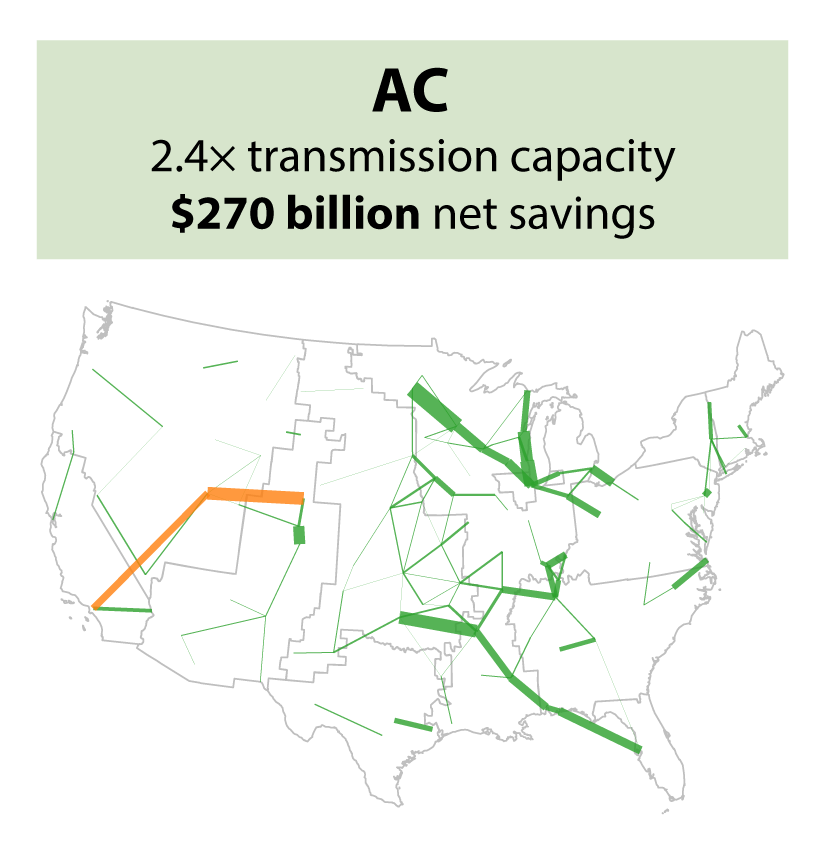
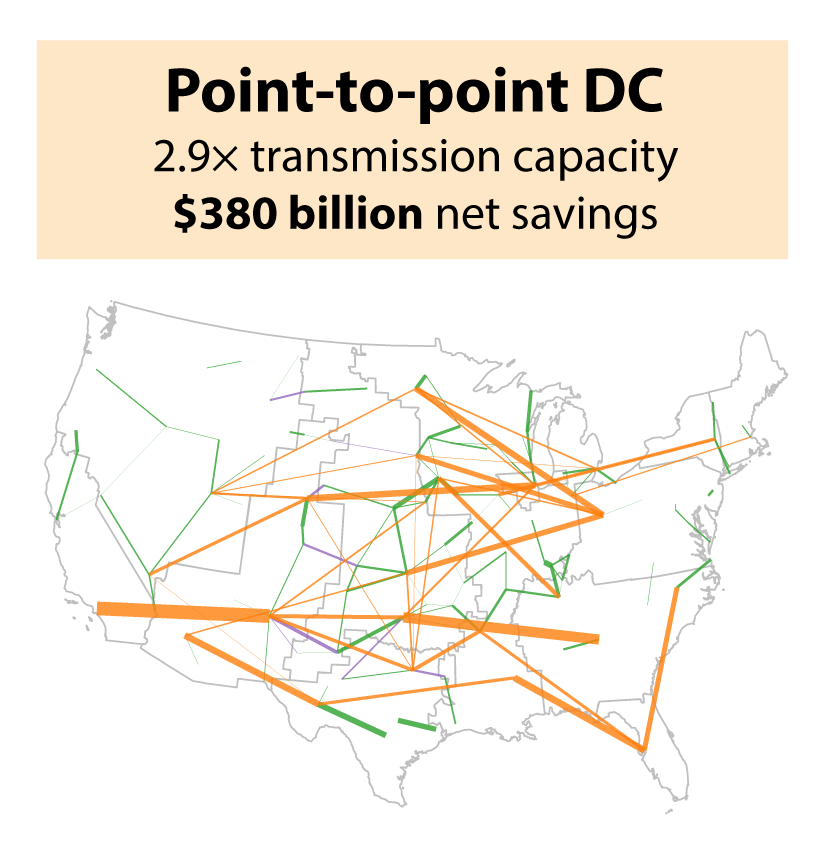

Expansion of transmission capacity in the United States could result in billions of dollars of U.S. electricity system cost savings. As outlined by three scenario frameworks—alternating current (AC), point-to-point direct current (DC), and multiterminal DC—the total cost savings increases with the level of transmission expansion. Graphics by Christopher Schwing, NREL
Increasing transmission infrastructure could significantly cut electricity sector carbon emissions under current policies by providing access to the nation's most abundant, low-cost renewable energy resources: wind and solar.
While new transmission infrastructure would be installed across the contiguous United States, the biggest expansion would take place in the country's central wind belt, where long-distance lines are especially important.
Transmission expansion and renewable energy deployment are complementary in all scenarios, but they are particularly synergistic in net-zero-emissions futures where wind and solar provide up to about 90% of total electricity generation by 2050. The remaining energy comes from hydropower, other renewable sources, nuclear power, fossil with carbon capture and storage, and hydrogen.
In addition to providing access to the nation's best wind and solar resources, expanded transmission could also offer major reliability benefits for the future energy system.
All the modeled future grids in the study meet or exceed resource adequacy standards, which ensure the power system can supply enough electricity—at the right locations—to keep the lights on. Coordinating transmission between regions and using it in both directions could help support reliability while lowering system costs by hundreds of billions of dollars through 2050.
"Wind or solar aren't always available everywhere, but they're always available somewhere, and expanding transmission and coordination between regions helps maintain a reliable system for everyone involved," NREL Grid Modeler Patrick Brown said.
The study team analyzed several other reliability indicators by modeling at the nodal level, where individual substations, transmission lines, and power plants are represented. The nodal analysis included production cost modeling with power flow and contingency analysis of the entire contiguous U.S. system as well as western U.S. power flow (executed by Pacific Northwest National Laboratory) and extreme weather stress case studies.
"By incorporating nodal analysis, we can study transmission network expansion needs with the resulting power flows and voltages in detail over tens of thousands of substations and transmission lines across the U.S.," NREL Engineer Jarrad Wright said. "This rigorous approach helps us better anticipate some of the engineering challenges that planners and operators may face as they undertake a transition of this magnitude."
Year 2035 Projections
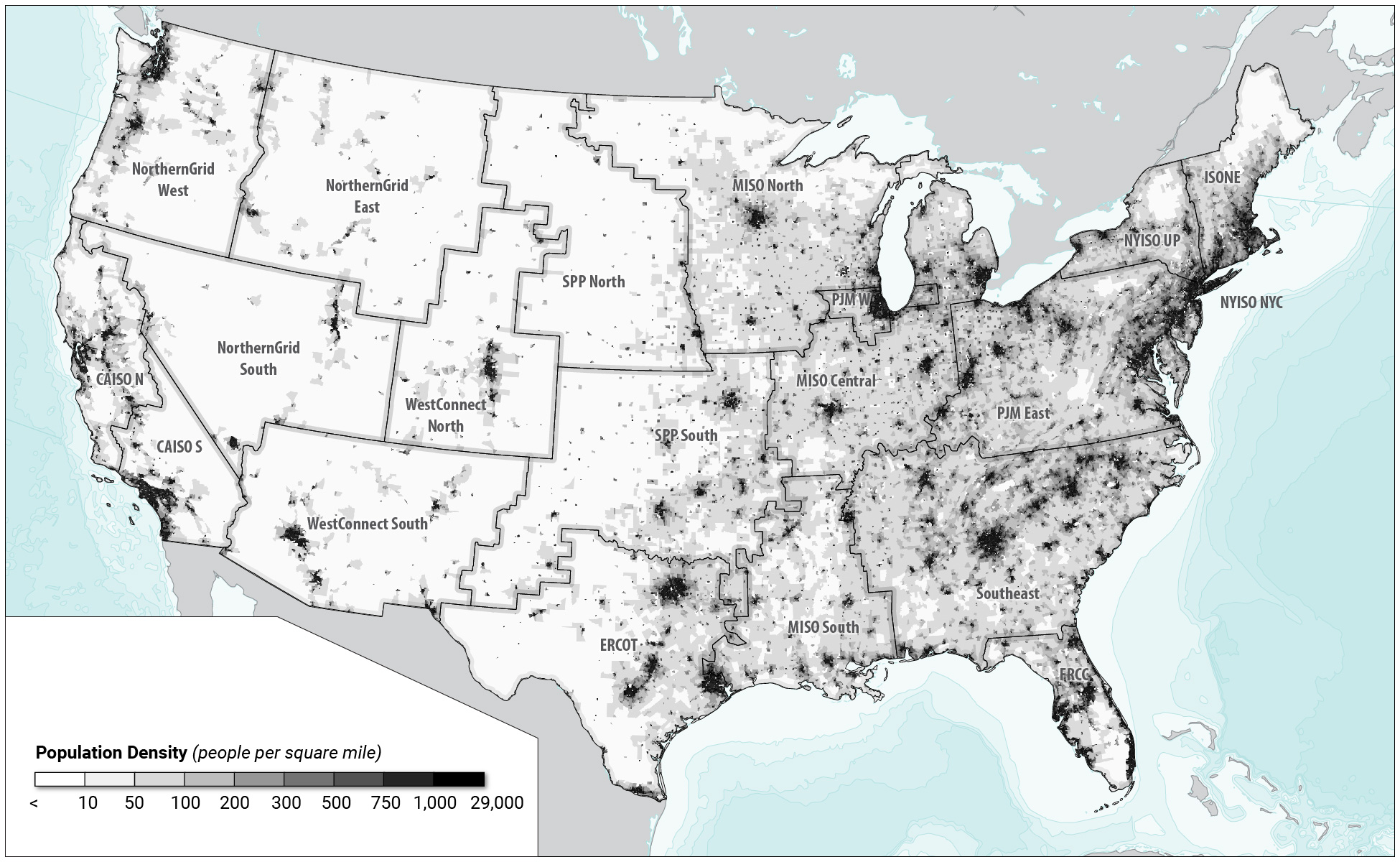
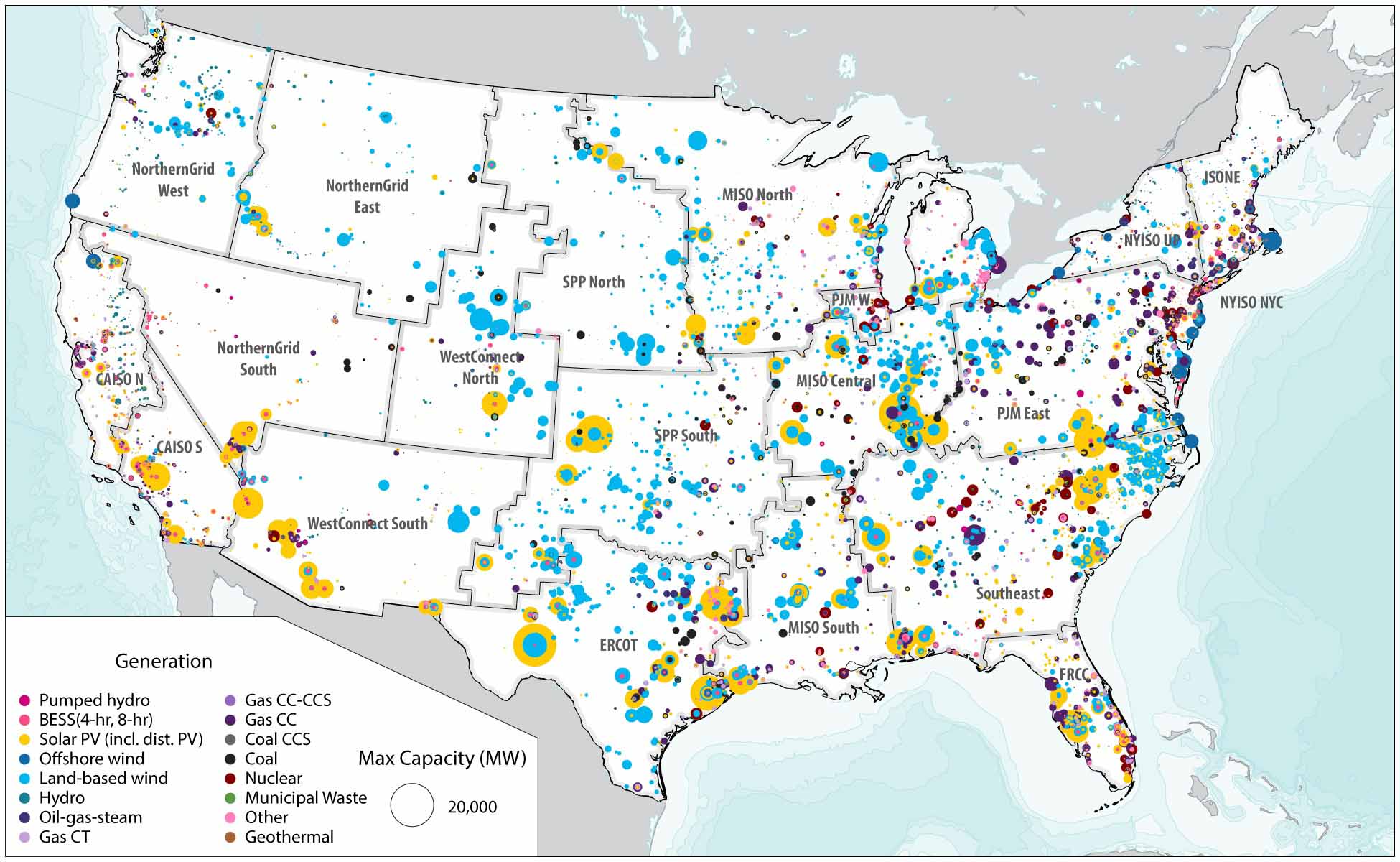
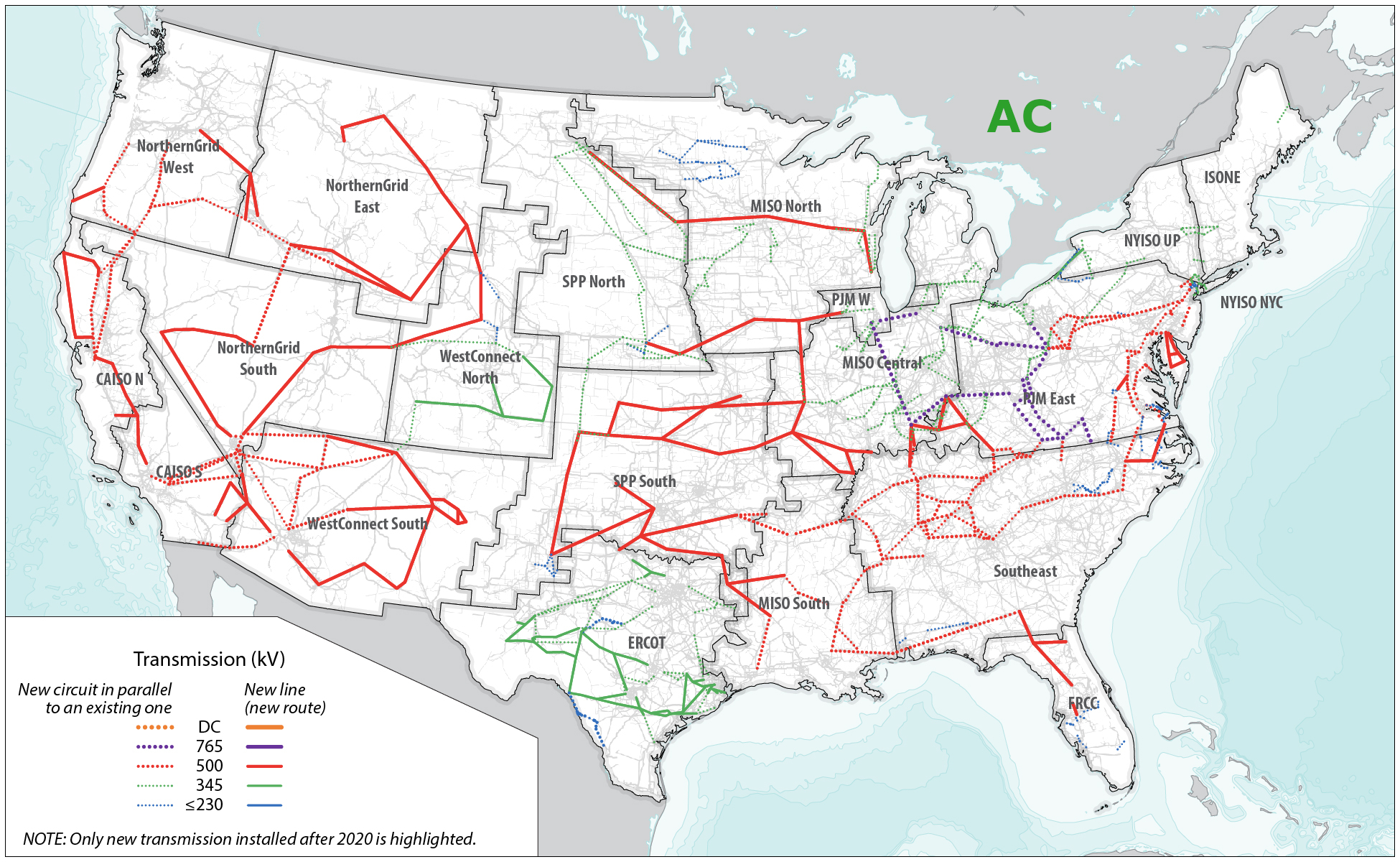
The study team performed nodal analysis of U.S. transmission expansion scenarios, providing valuable insights into potential challenges that could arise as planners and operators manage large-scale transitions. Graphic by Billy Roberts, NREL
The NTP Study found the contiguous U.S. transmission system will need to at least double in size by 2050 to maintain reliability at the lowest cost to consumers. In scenarios with higher demand or higher decarbonization, the expansion of the transmission system is even greater.
"I was surprised by the scale of transmission growth in HVDC [high-voltage direct current] scenarios compared to those where HVDC transmission wasn't considered," Palchak said. "When we allow our models to consider these longer, cross-regional lines—something not typically done in current regional planning—we see significant opportunities for expanding transmission that result in larger cost savings and decarbonization benefits."
A challenging but crucial part of realizing the benefits of transmission expansion is adopting unprecedented planning approaches that can accommodate the energy needs for diverse regions at differing scales. Overcoming the current barriers to coordinated planning and interregional transmission will also be necessary. Steps could include unifying separate planning efforts, enabling model compatibility, and increasing data accessibility.
A companion report to the NTP Study explored how improving market and operating practices can enhance the value of interregional transmission by addressing current inefficiencies and proposing better coordination strategies.
"As part of this study, we identified near-term transmission options that were commonly chosen under a wide range of future technology, policy, and other possibilities," NREL Grid Modeler Anne Hamilton said. "We labeled those as high opportunity transmission (HOT) interfaces."
By identifying HOT interfaces, the researchers aimed to provide a strong starting point for planners and developers to accelerate transmission expansion.
A companion study to the NTP Study explored the economics of long-distance, high-voltage transmission lines linked to interregional renewable energy zones (IREZs) , or areas with abundant, low-cost renewable potential. The IREZ analysis can help local grid planners and decision makers tackle regulatory questions and advance interregional lines.
Indeed, the scale of transmission expansion modeled in this work is unprecedented, but insights from the NTP Study can set the nation on the path to an affordable, sustainable, and reliable future grid.
Listen to an in-depth discussion with three of the researchers on the NTP Study.
Learn about NREL's grid modernization and energy analysis research.
Share
Last Updated May 14, 2025

